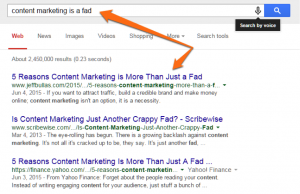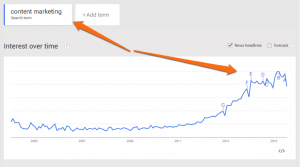5 Content Marketing Myths and SEO Lies You Probably Believe
Content Marketing Myths
Content marketing can bring massive results, but it also remains one of the most misunderstood marketing fields. Few marketers understand it, and even fewer know how to get it right.
The end result is thousands of marketing dollars wasted with little to show for it than an empty blog and and sparse social following.
All this has given rise to a number of myths about content marketing & SEO. Some believe that you can’t measure its success, while others believe that it can’t work for B2B segments.
We’ll dispel some of these myths below.
Myth #1: Content marketing works only for B2C
This is a pervasive myth that has stopped many a fledgling content marketing campaigns from taking off – the belief that content marketing can’t work for B2B segments.
The Reality: Nothing could’ve been further from the truth. Countless examples show that content marketing is as, if not more effective in B2B as it is in B2C.
Why?
Two reasons:
- The average B2B buyer reads between 2 and 5 pieces of content before making a purchase decision.
- B2B buyers complete nearly 57% of the buyer’s journey before even talking to a sales rep.
Thus, content marketing helps your potential customers find you online, and make better buying decisions by reading your content.
KISSMetrics, Moz, HubSpot, InsideSales, Groove – these are all examples of businesses that have used content marketing to grow in B2B markets.
Myth #2: You can’t measure the ROI of content marketing
Marketers are hesitant to invest in content because they believe they can’t measure its ROI. Instead, they’d rather invest in marketing they can measure, such as PPC.
The Reality: It’s easy to understand the origins of this myth. Unlike PPC, content is subjective. You can’t always predict what content leads to a new sale or a sign-up. This has led to a belief that it is impossible to measure the ROI of content marketing and SEO.
Fortunately, analytics tools have improved drastically over the last five years. With Google Analytics, Mixpanel, KISSMetrics, etc. you can see exactly who consumed your content and how they fit into your sales funnel, typically managed via an email marketing campaign.
This is one reason why 41% of content marketers claim that content marketing has a positive ROI.
Myth #3: Creating content is easy
Ten years ago, the above statement would have been true. Due to a lack of competition, you could get away with creating low quality content and gaming search engines.
Today, your competition has improved drastically. 2,000 word blog posts with tons of visuals and mini-infographics are becoming commonplace. Content marketers are constantly pushing the envelope of what’s possible with content.
To win against this competition you need to invest in quality writers and top-notch design. This means eschewing the $5/article freelancers, and hiring dedicated content creators who know how to write for the web, do in-depth research, and tell your story.
This is the reason why ‘content creator’ is one of the fastest growing jobs in the US.
Myth #4: Content marketing is just a fad
A lot of businesses have heard of content marketing and how effective it can be. Yet, they continue to believe that it’s just some hyped up fad that will disappear in a few years.
This explains search results like these:
The Reality: Content marketing and SEO are here to stay. Even though it is a relatively new marketing field, it has shown constant growth over the last decade.
Here’s what Google Trends has to say about it:
In fact, if you look at the statistics, it’s clear that content marketing is only going to increase in relevance:
- 78% of marketers are creating more content than they were a year ago
- 91% of marketers are now using content marketing
- Content marketing is a $44B industry in the US alone
- 58% of B2B marketers are increasing their content marketing budgets
The truth is that offering content to sell a product is one of the oldest marketing tactics in existence. For example, John Deere sold a magazine farmer’s magazine called Furrow way back in 1895 to increase sales of its farming products.
Content marketing is here to stay. It isn’t a passing fad or a trendy new buzzword. It is a powerful marketing tactic that delivers tremendous value to customers, while helping businesses sell more.
Myth #5: Content marketing is only about creating content
Another belief shared by many businesses is that if you create content, everything else falls into place. This is why so few businesses invest in actually marketing their content.
The Reality: “Build it and they’ll come” might work for baseball movies, but it hardly works for content marketing. Creating content might be a big part of content marketing and SEO, but to win big, you also need to distribute your content.
According to Forbes, only 26% of marketers invest in content distribution. This is why you see so many blogs with stellar content but few readers.
A sound content distribution strategy should focus on owned, earned and paid media channels:
- Owned: These are platforms you ‘own’ or control directly. Focus on establishing a presence on multiple platforms (YouTube, Facebook, blog, Twitter, etc.) and automating distribution as much as possible.
- Earned: This is ‘word of mouth’ or when people share your content. Getting traction on this channel is a function of your content quality and reach. Create top-notch content, continue to grow your owned media presence and you just might reach the scale required for word of mouth or viral spread.
- Paid: This is when you pay a platform to spread your content, such as Facebook ads. When strategically used, paid channels can be extremely useful for boosting content distribution. Consider putting a few dollars per post in Facebook or Twitter ads to complement your earned and owned distribution.
As with many things, the Pareto principle (or the 80/20 rule) applies here as well: 20% of your time should be spent creating content, remaining 80% distributing it.
Content marketing is one of the most exciting new marketing developments in the last few years. It has leveled the playing field and given small businesses the tools to compete against the big boys.
What do you think? Which of these myths has stopped you from using content marketing in your business?





